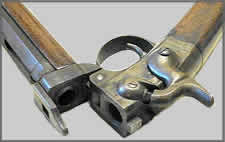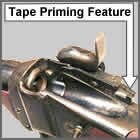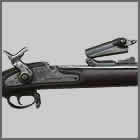Home | Glossary | Resources | Help | Contact Us | Course Map
Archival Notice
This is an archive page that is no longer being updated. It may contain outdated information and links may no longer function as originally intended.
Breech-Loading Firearm Design
Dating back to flint-fired models, breech-loading firearms were very complex and expensive. During the percussion cap era, breechloaders proliferated. Nearly all used a cartridge that consisted of paper or linen wrapped around powder and a ball. Variations of cartridges containing a projectile and propellant existed for many years, yet they still relied on an externally mounted percussion cap.
To evolve from the percussion cap to a completely self-contained cartridge, three things had to happen:
- The hammer blow had to be transferred to the interior of the arm where the cartridge rested.
- The arm had to be breech loaded, which required an open end opposite the muzzle to accept true cartridges (projectile, propellant, and primer).
- A locking mechanism on the arm was required to contain the cartridge during the pressure of firing.
To satisfy the first requirement, a rod was placed between the hammer and the now remote cap. This allowed the hammer to fall on the rod (firing pin), driving it into the cartridge cap, now called a primer. In some designs (notably revolvers), the cartridge was not so remote as to require a separate part; the firing pin could be as simple a small protrusion on the nose of the hammer.
Transitional Adaptations
The basic mechanisms were convenient for the percussion shooter and easily adapted to the breech mechanisms found in modern arms. Some percussion breechloaders were cleverly converted to fire modern cartridges with internal ignition. The early locking mechanism was usually robust enough to safely control a modern cartridge. The Sharps rifle is a noteworthy and familiar example. As a breech-loading percussion rifle for military use, it was easily modified to become one of the famous cartridge firearms of the American West.
In addition, the 1863 U.S. Springfield and the British 1853 Pattern Enfield (both .58 caliber rifled muskets) were converted to fire true cartridges by literally cutting off the top half of the breech area. The resulting cavity was filled with a hinged breechblock that was fitted with a long firing pin. The mechanism was locked using a rudimentary spring latch.
| Conversions |
| In this image of a percussion Sharps rifle converted to cartridge (below left), the device under the hammer spur is a leftover feature for tape priming, revealing the percussion heritage of the rifle. |
Breech Sealing
The weak point of the percussion breechloader was breech sealing. Few systems were secure enough to prevent the shooter from being blasted in the face and eyes by hot gas. Unfortunately, fine tolerances and fitting could not stand up to the effects of hot corrosive gases under battle conditions.
Any correction to the sealing problem required balancing two design considerations:
- The tolerances of the breech mechanism must be loose enough to allow the arm to function under conditions of extreme dirt and powder fouling.
- The effective sealing of the breech end of the arm against gas leakage must be accomplished by the very slight expansion of the typically soft brass cartridge (obturation) during firing.
Correcting the tolerance issue was easy. Loose tolerances are a proven approach and design philosophy in firearms manufacture. Parts should be loose enough to prevent the problems that stop a firearm from operating, such as neglect and dirt. The cartridge gas seal function required another leap of technology that will be covered in the evolution of the cartridge.
Additional Online Courses
- What Every First Responding Officer Should Know About DNA Evidence
- Collecting DNA Evidence at Property Crime Scenes
- DNA – A Prosecutor’s Practice Notebook
- Crime Scene and DNA Basics
- Laboratory Safety Programs
- DNA Amplification
- Population Genetics and Statistics
- Non-STR DNA Markers: SNPs, Y-STRs, LCN and mtDNA
- Firearms Examiner Training
- Forensic DNA Education for Law Enforcement Decisionmakers
- What Every Investigator and Evidence Technician Should Know About DNA Evidence
- Principles of Forensic DNA for Officers of the Court
- Law 101: Legal Guide for the Forensic Expert
- Laboratory Orientation and Testing of Body Fluids and Tissues
- DNA Extraction and Quantitation
- STR Data Analysis and Interpretation
- Communication Skills, Report Writing, and Courtroom Testimony
- Español for Law Enforcement
- Amplified DNA Product Separation for Forensic Analysts






